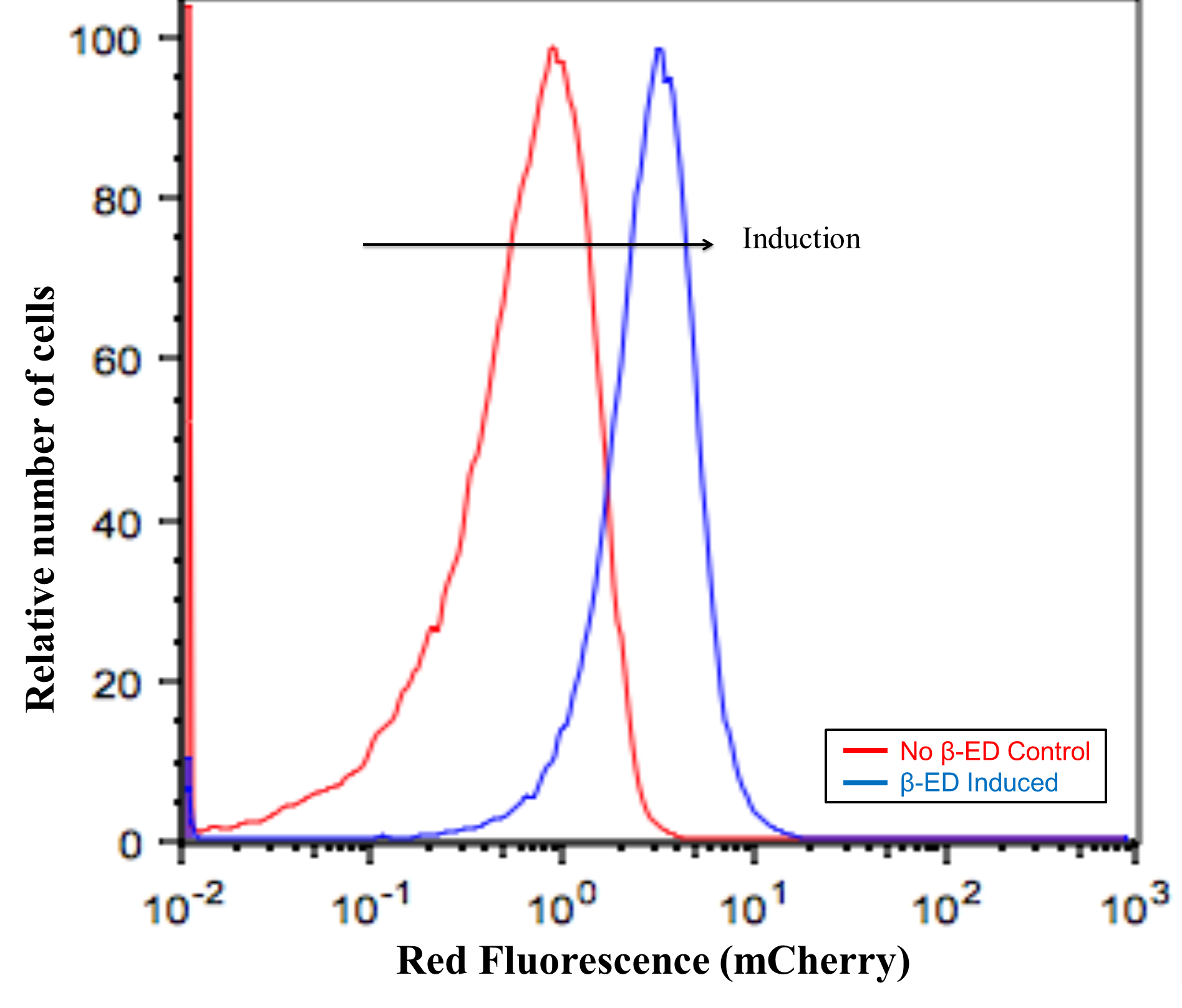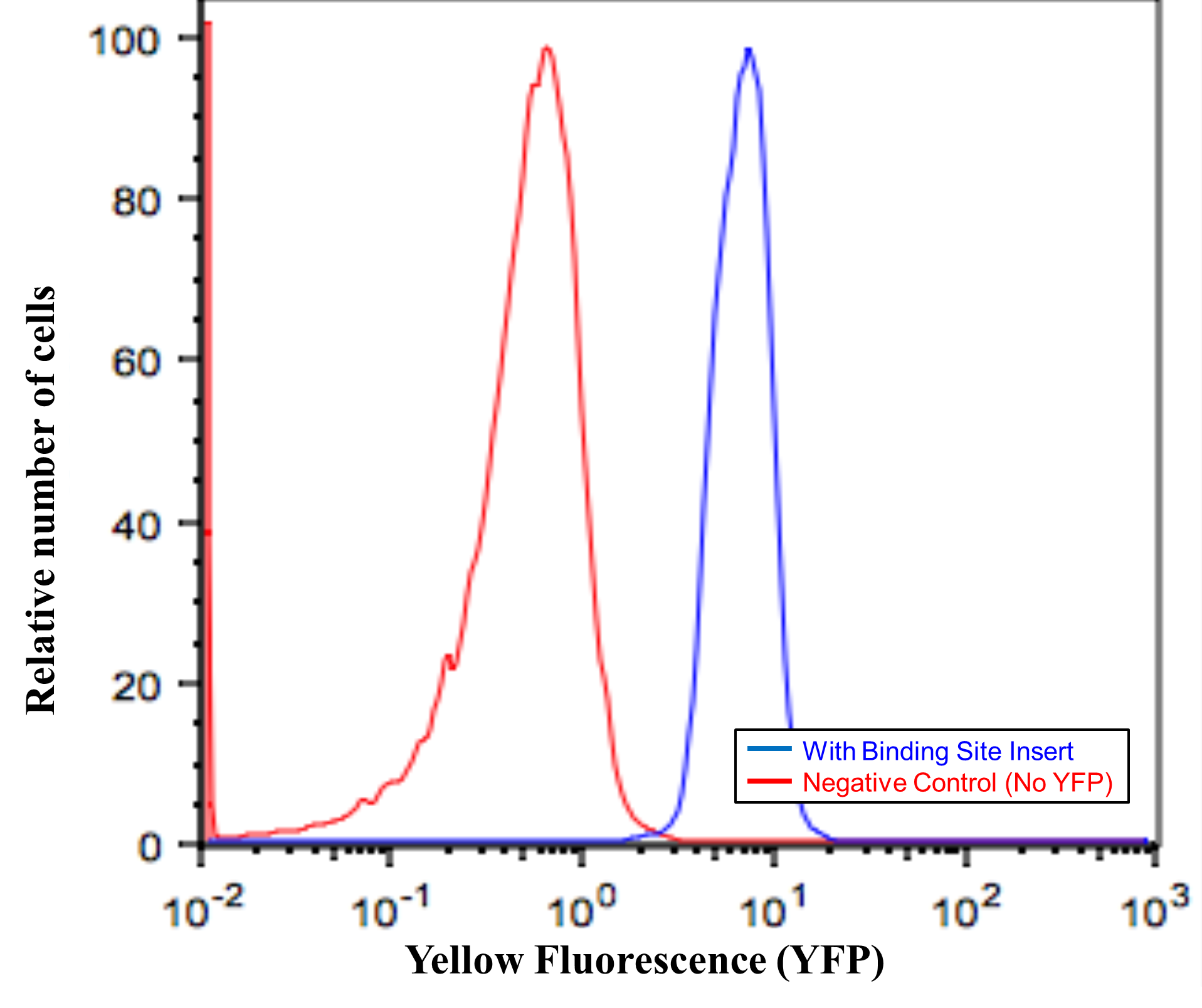Team:Duke/Project/Results/Part2
From 2013.igem.org
(Difference between revisions)
Hyunsoo kim (Talk | contribs) (→TALEs) |
(→TEF1 reporters) |
||
| (11 intermediate revisions not shown) | |||
| Line 12: | Line 12: | ||
| - | [[File:TaleInduction.png| | + | [[File:TaleInduction.png|450px|center]] <br> |
| - | <div align="center"> Figure 1.5.1. | + | <div align="center"> Figure 1.5.1. Change in Fluorescence with β-estradiol Induction</div> |
<br> | <br> | ||
<br> | <br> | ||
| - | *Relationship between beta-estradiol concentration and TALE-mCherry expression | + | *Relationship between beta-estradiol concentration and TALE-mCherry expression: Cells were grown in varied β-estradiol concentrations and fluorescence was compared to background levels using a control strain. The induction curves are shown for four strains of yeast that produced different TALEs (16B, 16C, 20B, and 20C) with β-ED concentrations of 0.1nM through 1000nM |
| - | [[File:TaleInduction2.png| | + | [[File:TaleInduction2.png|730px|center]] <br> |
| - | <div align="center"> Figure 1.5.2. | + | <div align="center"> Figure 1.5.2. Induction Curves for TALEs with Varying β-estradiol Concentrations</div> |
<br> | <br> | ||
<br> | <br> | ||
| Line 26: | Line 26: | ||
==ACT1 reporters== | ==ACT1 reporters== | ||
| - | *Initial characterization: ACT1-yEVenus constructs with no operators showed distinct constitutive gene expression. However, presence of operator sites in the 5' UTR knocked down constitutive expression almost to background levels. In lieu of these results, we decided to construct TEF1-promoter reporter constructs. TEF1 is a stronger constitutive promoter that we hoped would counteract the effects of the operator sequence on constitutive expression levels. | + | *Initial characterization: ACT1-yEVenus constructs with no operators showed distinct constitutive gene expression (green). However, presence of operator sites in the 5' UTR knocked down constitutive expression almost to background levels. In lieu of these results, we decided to construct TEF1-promoter reporter constructs. TEF1 is a stronger constitutive promoter that we hoped would counteract the effects of the operator sequence on constitutive expression levels. |
| - | + | ||
| - | + | ||
| - | [[File:ActReporter.png| | + | |
| - | <div align="center"> Figure 1.5.3. | + | |
| + | [[File:ActReporter.png|450px|center]] <br> | ||
| + | <div align="center"> Figure 1.5.3. Reduced ACT1 Promoter Activity with Binding Sites in 5' UTR </div> | ||
<br> | <br> | ||
<br> | <br> | ||
| Line 37: | Line 37: | ||
==TEF1 reporters== | ==TEF1 reporters== | ||
| - | *Initial characterization: TEF1-yEVenus constructs with operator sites in the 5' UTR showed expression levels significantly higher than background levels, and comparatively higher than the ACT1-yEVenus constructs. | + | *Initial characterization: The TEF1-yEVenus constructs with operator sites in the 5' UTR that were submitted as BioBricks showed expression levels significantly higher than background levels, and comparatively higher than the ACT1-yEVenus constructs. This makes them suitable for further experiments measuring cooperativity of repression. The shift in fluorescence for BBa_K1204021, the 3x16C binding site reporter construct is shown below. |
<br> | <br> | ||
<br> | <br> | ||
| - | [[File: | + | |
| - | <div align="center"> Figure 1.5. | + | [[File:TefReporter.png|450px|center]] <br> |
| + | <div align="center"> Figure 1.5.3. Strong TEF1 Promoter Activity in BBa_K1204021 3x16C Binding Site Reporter Construct</div> | ||
<br> | <br> | ||
<br> | <br> | ||
Latest revision as of 01:56, 28 September 2013
Contents |
Results: Part Characterization using Flow Cytometry
After being integrated into the yeast genome, parts were characterized individually by flow cytometry.
TALEs
- Initial characterization: TALE-mCherry constructs are present and expression is inducible by β-estradiol. Cells were grown with and without β-estradiol and fluorescence was compared to background levels using a control strain. Our flow cytometry data shows ~4 fold increase in fluorescence with β-estradiol, indicating TALE transcription with operating mCherry tag.
Figure 1.5.1. Change in Fluorescence with β-estradiol Induction
- Relationship between beta-estradiol concentration and TALE-mCherry expression: Cells were grown in varied β-estradiol concentrations and fluorescence was compared to background levels using a control strain. The induction curves are shown for four strains of yeast that produced different TALEs (16B, 16C, 20B, and 20C) with β-ED concentrations of 0.1nM through 1000nM
Figure 1.5.2. Induction Curves for TALEs with Varying β-estradiol Concentrations
ACT1 reporters
- Initial characterization: ACT1-yEVenus constructs with no operators showed distinct constitutive gene expression (green). However, presence of operator sites in the 5' UTR knocked down constitutive expression almost to background levels. In lieu of these results, we decided to construct TEF1-promoter reporter constructs. TEF1 is a stronger constitutive promoter that we hoped would counteract the effects of the operator sequence on constitutive expression levels.
Figure 1.5.3. Reduced ACT1 Promoter Activity with Binding Sites in 5' UTR
TEF1 reporters
- Initial characterization: The TEF1-yEVenus constructs with operator sites in the 5' UTR that were submitted as BioBricks showed expression levels significantly higher than background levels, and comparatively higher than the ACT1-yEVenus constructs. This makes them suitable for further experiments measuring cooperativity of repression. The shift in fluorescence for BBa_K1204021, the 3x16C binding site reporter construct is shown below.
Figure 1.5.3. Strong TEF1 Promoter Activity in BBa_K1204021 3x16C Binding Site Reporter Construct
 "
"














